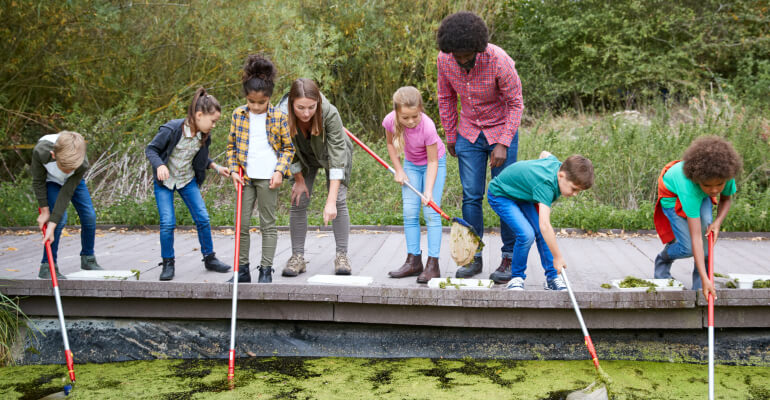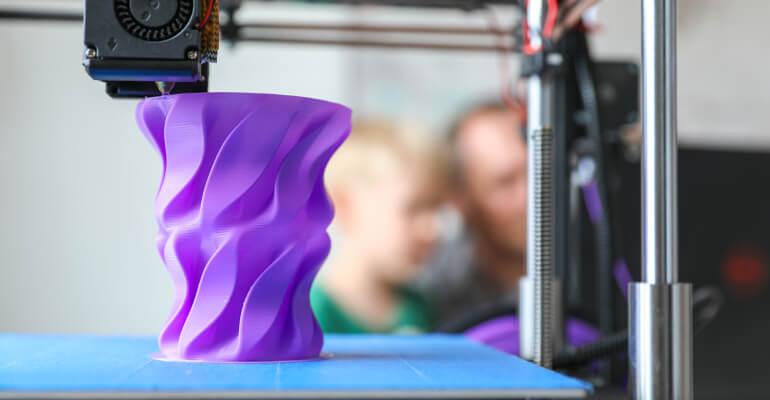The current state of education is a regular topic of news and conversation across the nation. In 2024, the subjects of STEM (science, technology, engineering, and mathematics) will continue to be foundational to the latest developments in education and essential to many of the most in-demand career pathways.
Scientific breakthroughs and technological developments are happening everyday, and it can be hard to sort through all the noise to understand which trends and innovations are relevant and important. This means it’s more important than ever for students to engage with STEM in the classroom and develop robust STEM identities.
Below we gathered some of the key trends we expect to see in STEM education in 2024. If you’re looking for more, check out our article on the top STEM education trends for 2023 and see how those trends have changed over the past year.

Multimodal Learning Approach
For many years, educators have implemented techniques that support different learning styles. In 2024 and beyond, we expect to see that interest shine a light on the benefits of a multimodal learning approach, which aligns well with the hands-on nature of STEM education.
According to the Encyclopedia of the Sciences of Learning, “Multimodal learning refers to an embodied learning situation which engages multiple sensory systems and action systems of the learner.” Multimodal learning uses different modes, or channels of information, to communicate meaning and information via the different senses.
With multimodal learning, students are supported whether they use the visual, auditory, read/write, or kinesthetic learning type, or some combination of learning types. STEM education often requires the hands-on learning experiences that benefit kinesthetic learners, so it’s important for teachers to ensure that other learning modes are supported through accompanying text, classroom collaboration, and visual aids.
Career and Technical Education Programs
STEM careers are projected to continue to be in high demand, but not all of those careers require a traditional secondary education. In order to better serve students who may not want to attend a four-year university after high school, career and technical education (CTE) programs have been on the rise across the country.
These programs provide high school and college students with education tailored to specific in-demand skilled jobs, many of which incorporate STEM subjects alongside technical, real-world instruction. According to the Government Accountability Office, about 11 million students took part in CTE programs in the 2019 to 2020 academic year, with $1.3 billion in federal funding going toward these programs from the Department of Education.
CTE programs can occur in high schools, technical schools, community colleges, traditional universities, and more. Many of the programs feature unique benefits like potential apprenticeships, internships, clinical experiences, and other practical learning opportunities that give students a headstart on their future career.
The 16 career and technical education areas of study include:
- Health Science
- Business
- Sales
- Finance
- Information Technology
- Science, Technology, Engineering, and Math
- Manufacturing
- Logistics
- Hospitality
- Government
- Law
- Agriculture
- Human Services
- Construction
- Training
- Arts, Audio/Visual Technology, and Communications
In 2024, we expect to see a continued focus on the implementation and success of career and technical education programs, as the jobs associated with these pathways keep growing in demand.

Sustainability in the Classroom
Students will inevitably deal with sustainability, climate change, and related global issues, but a strong STEM education can better equip them for the future. A sustainable mindset can start in the classroom.
Sustainability is a natural focus area for STEM—and often an area that students will be enthusiastic about learning. You may think that sustainability only ties to environmental science, but it can also align well with lessons on engineering and technology, as those fields allow for the development of structures and solutions that have a positive impact on the world.
STEM education focuses extensively on real-world problems and real-world solutions, just like questions of how students can contribute to a more sustainable future. Sustainability also serves as the central focus to many STEM careers that students may eventually pursue, such as environmental engineering, ecology, and agricultural science.
Fortunately, incorporating sustainability to your STEM classroom does not have to be too taxing, as there are many great organizations that provide relevant resources, including Project Green Schools, Earth Force, and the Green Schools Alliance.
Updated Educator Pipeline and Recruitment
Across the country, school districts are expanding their focus on STEM curriculum and programs, and that means more STEM educators are needed. The shortage of STEM teachers, though, has proved to be chronic in recent years.
ABC News reports that at least 40 states are reporting ongoing teacher shortages, with the most acute shortages occurring in special education and STEM. In particular, there is a lack of diverse teachers in STEM, with 79% of STEM teachers being non-hispanic or white, according to the National Center for Education Statistics.
When it comes to learning STEM, a mentor can make all the difference, and for students of traditionally underrepresented groups, there are particular benefits for having educators who look like them and reflect aspects of their own lived experiences.
In 2024, experts in STEM education will continue to focus on addressing and overcoming this issue. One leading organization addressing the STEM teacher shortage is Beyond100K, whose approach focuses on, “Preparing and retaining excellent and diverse STEM teachers, so that teachers and students, especially those of color, thrive and persist in STEM.” Working with 130 different organizations, Beyond100K has recruited 100,000 STEM educators over the past 10 years, with the goal of completely closing the gap by 2043.

New Technology in the Classroom
There are plenty of benefits of conducting traditional STEM lessons in the classroom, as these science experiments can help students understand key concepts of STEM. With the increased emphasis on the technology of the future, though, it’s important to incorporate the tools that reflect this ever-evolving version of STEM, bringing that technology into the classroom.
Examples of this technology include:
- Robotics
- Augmented and virtual reality
- 3D printers and scanners
- Engineering software
- Coding platforms
When students have access to hands-on learning materials, they can be more engaged with the lesson and connect what they learn to their real-world experiences.
For STEM teachers looking for a reliable option, we recommend our STEM lab kits, which include durable supplies and accompanying curricula and lesson materials.
Emphasis on Digital Literacy
The digital age isn’t going away, so students should be educated on how to interact with technology, the internet, and related avenues of information and communication. Often, we consider young people to naturally be adept at navigating the digital sphere, yet that thinking can set many students up for potential failure and challenges.
The American Library Association’s Digital Literacy Task Force defines digital literacy as “the ability to use information and communication technologies to find, evaluate, create, and communicate information, requiring both cognitive and technical skills.” Digital literacy is an essential skill for students as they navigate learning across digital platforms, discerning what information is reliable and what should be disregarded.
Through digital literacy, students are able to utilize all the technology and resources available to them in order to solve problems, collaborate, and communicate effectively in STEM subjects and beyond. Digital literacy requires a level of critical thinking that must be practiced and STEM identity that must be developed.

Better Resources for Teachers
Like other educators, STEM teachers must juggle an array of demands, challenges, and responsibilities, all while serving the unique academic and emotional needs of their classrooms. To help STEM teachers in 2024, we’ve seen growing hubs of resources that provide lesson ideas, instructions, curriculum materials, and more.
STEM education resources we recommend include:
- U.S. National Science Foundation
- Smithsonian Science Education Center
- NASA
- NASA Jet Propulsion Laboratory
- National Inventors Hall of Fame
- CK-12
- Hour of Code
- Code.org
- NOAA National Marine Sanctuaries
- Department of Energy STEM
- Girlstart
- Monterey Bay Aquarium
- National Park Service
When it comes to complete support for STEM teachers, the STEM labs from Kid Spark Education include everything teachers need, from the durable, reusable materials to the lesson plans and instructions to utilize in the classroom.
Expanded STEM Careers
When we discuss careers in STEM, the first job titles that come to mind are often those that come from the titular subjects, like scientist and engineer. However, job opportunities in STEM are expansive and ever-growing. Additionally, we expect to see a broader understanding of an emphasis on STEM careers that are not traditionally “white collar” or office jobs, like those trade jobs that can be pursued from career and technical education programs.
Those jobs in particular are referred to as middle-skill STEM jobs, since they require more than a high school degree but less than a bachelor's degree. These STEM careers are particularly plentiful, as Learning Undefeated estimated that more than half of STEM jobs do not require a bachelor’s degree and often serve some of the most in-demand occupations and industries.
Some examples of these middle-skill STEM careers, as detailed by the National Science Foundation, include:
- Healthcare practitioners, like x-ray technicians and healthcare aides
- Specialized mechanics, like aircraft mechanics and small engine mechanics
- Manufacturing jobs, like structural metal fabricators and production operation supervisors
- Energy jobs, like solar installers and mining operators
- Construction jobs, like building inspectors and electricians
In the classroom, this shift in workforce demand should be reflected through an exposure to all the different STEM career paths available to students.
Increased Focus on Accessibility
Just as students from all backgrounds deserve an equitable STEM education, students with disabilities also deserve to develop strong STEM identities, allowing them to envision futures where they can have STEM careers. However, accessibility in education is not always consistently addressed, even in the forward-thinking STEM subjects.
This issue is detailed in an article from the University of North Carolina at Chapel Hill Frank Porter Graham Child Development Institute, which explains that “not all children are given equal access to these activities that have the power to boost brain development and spark curiosity and joy. Very young children with disabilities are often excluded from STEM activities in educational settings, mostly due to attitudes and beliefs about those children's capacities for learning.”
When students with different abilities are included in STEM learning, all students benefit. However, students with disabilities tend to be left out of these essential education experiences early in their academic careers, and, from there, they are left behind.
In 2024, STEM teachers and the programs they use should focus on creating inclusive classrooms where all students can participate. For ideas on where to get started, check out the National Center on Accessible Education Materials and their resources.
Cross-Curricular Collaboration
As the importance of STEM education has been increasingly accepted, we’ve begun to see the connection between STEM and other subjects grow, leading to more cross-curricular STEM learning experiences. In practice, cross-curricular learning brings together different academic subjects in the same lesson, teaching principles of both subjects as well as their value to one another.
This type of learning is great for students who struggle in one subject but are passionate about another, since it can help them approach whichever subject is more challenging with a renewed focus and problem-solving process. It also challenges students to think creatively and look for out-of-the-box solutions.
Finally, cross-curricular learning also aligns with how students will eventually have to deal with real-world problems, since problems outside of the classroom rarely stay siloed to a particular academic subject matter. As students progress through high school and college, they’ll find more and more of this type of challenge, so it benefits them greatly to experience it early.
Prepare for the Future of STEM Education with Kid Spark Education
If you’re looking to refresh your STEM curriculum in 2024, Kid Spark Education can provide the STEM programs, resources, and support to do so. Create a free account to explore the sample STEM curriculum, or contact our team today to learn more about our programs.
.png?width=1270&height=453&name=Copy%20of%20Kid%20Spark%20Logo%20(Horizontal%20-%20Full%20Color).png)